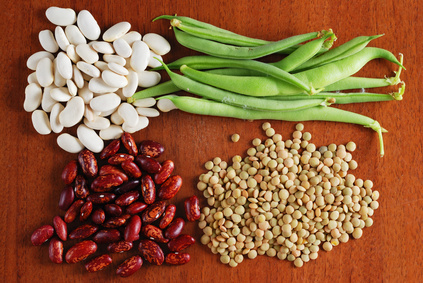A recent study illustrating that too much protein can reduce your life span prompted me to write a series of articles about how much protein you really need for building muscle, or just to live a long and healthy life. In this final article of the series, I want to talk about a common source of confusion regarding plant protein: complete versus incomplete proteins.
It is extremely common to come across the idea that plant proteins are 'incomplete', and therefore are inferior to animal-based proteins. Often you will also see that plant proteins need to be combined in some sort of complicated fashion to make a healthy, 'complete' protein your body will be able to use. So, just what does it mean for a protein to be complete? Proteins are made up of basic building blocks called amino acids which link together to form proteins, like train cars linking together to form a freight train, or letters in the alphabet linking together to form words. There are 21 different amino acids the human body uses, of which nine are essential, meaning your body cannot make them from other amino acids and must get them from the food you eat. A complete protein is a protein which contains all nine of the essential amino acids that the human body needs and cannot make on its own. By this definition, every single plant protein found in nature is complete. In fact, the only protein I've been able to find which does not contain all of the essential amino acids is gelatin - an animal derived protein! This means that you could eat any single whole plant food exclusively, and while you might have all sorts of other nutrient imbalances, as long as you were getting enough calories in, you would never be deficient in any of the essential amino acids!

The reason this myth is so prevalent (you even see it in some nutrition and medical texts) may have to do with a related concept: protein 'quality'. According to the USDA's National Nutrient Database for Standard Reference, "Protein quality is dependent on having all the essential amino acids in the proper proportions. If one or more amino acid is not present in sufficient amounts, the protein in your diet is considered incomplete [low-quality]". So, protein quality has to do with how much of each essential amino acid is present in a given protein - and a protein may be called incomplete, even though all nine essential amino acids are present, if the amounts are not up to a certain standard. So where did these standards come from? As it turns out, a study done at the very beginning of the 20th century on how different amino acid concentrations affect the growth rate of rats was used to rank protein quality. Animal protein, which has higher levels of the essential amino acids, allowed rats to grow faster than plant proteins, which were therefore dubbed of lower quality. The biggest problem with this measure of comparison is that humans aren't rats! When a follow up study was done by a different group focusing on adult humans in 1955, the human requirements for essential amino acids were found to be considerably lower than those from the rat studies - low enough to make any plant protein you care to name perfectly sufficient to be called 'high quality'. And this makes perfect sense. Rats grow to adulthood in a matter of months, whereas humans take around two decades - and that rapid growth requires more essential amino acids. That's probably also why rat breast milk has roughly ten times the protein concentration of human breast milk. And the reason this information likely isn't well know is simply how long ago the rat study was done. With all those years and many follow up studies confirming that animal proteins led to faster growth, the idea of animal protein as the benchmark of high quality protein become entrenched, as it mostly remains today.

So, hopefully now it can be said with certainty that plant proteins are 'complete' and of perfectly sufficient 'quality' to serve the needs of a healthy homo sapiens. There is absolutely no need to mix and match your whole plant foods with the intent of building a better protein to enhance your health, or to base your diet on soy and quinoa because those are the rare 'complete' proteins of the plant world. And besides, if you did want to focus on eating lots of plant proteins with higher concentrations of essential amino acids just for the fun of it, I've compiled a list below of as many whole plant foods as I could find with a high amino acid score on nutritiondata.com.
Pumpkin Seeds - 136
Avocado - 129
Turnip Greens - 128
Spinach - 119
Soy - 118
Black-Eyed Peas - 116
Chia Seeds - 115
Animal protein (Averaged Score of Beef, Milk and Eggs) - 114
Potatoes - 112
Persimmons - 110
Pistachios - 109
Chestnuts - 107
Quinoa - 106
Garbanzo Beans - 106
Kiwi Fruit - 105
Black Beans - 104
Great Northern Beans - 104
Kidney Beans - 103
Spirulina - 103
Cauliflower - 102
Peas - 102
Cashews - 100
Collards - 94
Kale - 93
Asparagus - 93
Pigeon Peas - 91
Navy Beans - 90
Zucchini - 90
Nutritiondata.com lists any food with an amino acid score over 100 as being 'complete', so even though we now know better, you can still have an easy time getting tons of whole plant foods with all the essential amino acids you could ever need. Enjoy!
References:
Rose W. The Amino Acids Requirements of Adult Man. Nutr Abst Rev. 1957;27: 63-67
Osbourne, Thomas, et al. Amino Acids in Nutrition and Growth. J. Biol. Chem. 1914, 17:325-349.
http://www.nutritiondata.com



Recommended Comments
There are no comments to display.